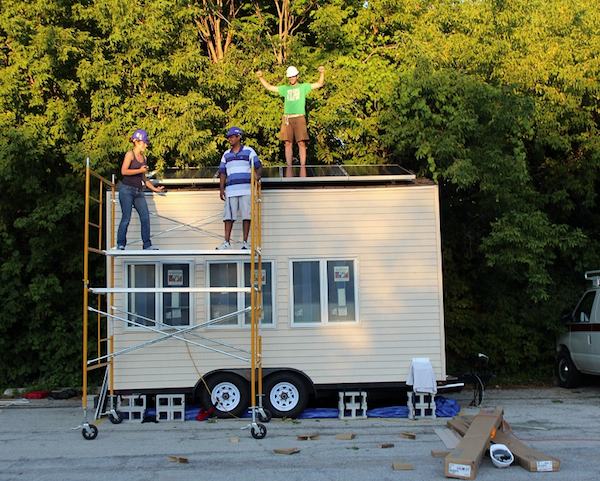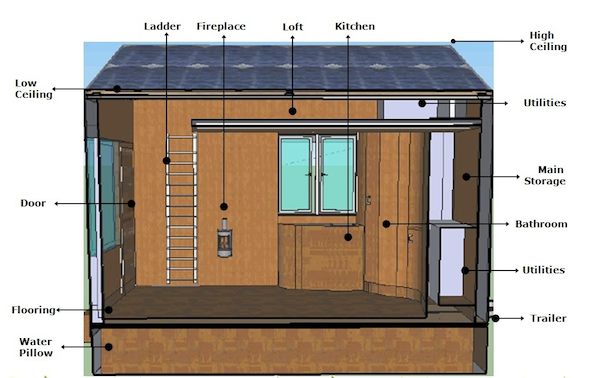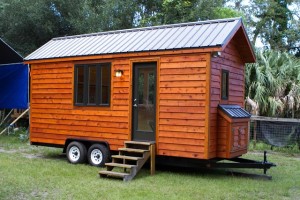This post contains affiliate links.
We haven’t featured Northwestern’s off grid tiny house project since April 2011.
Team CASITA’s mission is to create a sustainable and efficient home using smart design, electricity and plumbing.
The little structure is being built on a trailer. It’s just 128 square feet and has plans for solar panels and rainwater collection.
The roof is already covered with solar panels and there’s a battery bank to store all of the power.
Rainwater is collected for filtration and storage through the roof and four awnings.
They have a 500 gallon water pillow they plan to use to store the water.
Here’s one of the latest pictures after part of the solar panel installation.

Photo Credit: Northwestern University
The Layout
The design of the house includes everything a person could need. There’s a ladder so you can climb up to your sleeping loft and almost everything else is on the main level including:
- Water heater
- Solar panels
- Fireplace
- Kitchen
- Bathroom
Here’s an overview of where everything is located.

Photo Credit: Northwestern University
Building Materials
The trailer capacity is 7000 pounds. The house is framed with wood and is strong enough to withstand strong winds and snow.
Because this home is going to collect rainwater, a special kind of roofing material, called “Enviroshake” was chosen. It’s made out of 95% recycled plastic and is a good choice if you’re using solar panels too.
The flooring is going to be bamboo because it’s a renewable resource and is lightweight. Did you know that timber takes about 40 years to mature while bamboo takes just 4 years?
The insulation of choice was icynene spray foam. It sprays as a thin liquid that expands to 100 times its original size. This will definitely help keep the house warm.
Rain Water Collection System
Since the roof and the awnings collect rain water there’s a gutter system so it can travel to the 500 gallon water pillow.
From there it goes through a pump, a filter, and is distributed throughout the house.
Thanks to the large awnings planned, the rain water collection area is increased from just 128 to 320 square feet.
Before the water is stored it passes through a filter that removes debris from plants.
The water pillow is custom made to fit underneath the trailer between the wheels. It’s also going to be enclosed in an insulated box to prevent freezing.
The water storage system is emptied and the insulation can be removed and stored before transporting.
For more details on the plumbing click here.
The Casita Team that’s Making it Happen
These are the people who are making this tiny house a reality.
Students: Alejandro Sklar, William Fan, Andrea Morgan, Kaycee Overcash, Conor Cameron, Kevin Yngve, Kimberly Huang, Molly Baker, Taylor Lee, Vincent Zhang, Zachary Patterson and Laurel Lau.
Faculty: Karen Chou, Bruce Ankenman and Stacy Benjamin
Consultants: Mert Iseri and Alexandra Letuchy
More Pictures and Information
If you want to see more pictures on the progress of this house click here and you’ll be taken to NU’s tiny house project page where you’ll also find more details on the layout, materials, plumbing and electricity for the house.
Sources: https://sites.google.com/a/u.northwestern.edu/nutinyhouse/home/materials
https://sites.google.com/a/u.northwestern.edu/nutinyhouse/home/plumbing
This post contains affiliate links.
Alex
Latest posts by Alex (see all)
- Escape eBoho eZ Plus Tiny House for $39,975 - April 9, 2024
- Shannon’s Tiny Hilltop Hideaway in Cottontown, Tennessee - April 7, 2024
- Winnebago Revel Community: A Guide to Forums and Groups - March 25, 2024






Oh, to have the money to build one of these…